Theme Plaza Documentation
(based on VikBooking plugin)
Once you purchase the “Plaza” theme, you will get a “.zip” package. By accessing the control panel of your WordPress site, you will be able to install the “Plaza” theme by directly uploading the .zip file to the WordPress Upload Theme dashboard. When it is properly installed, you will need to activate it to move on to the next step.
In order to have the theme as our demo website, you can install the Sample Data in a very easy way by following these steps:
- Go on Appearance > Customize.
- Install and Activate to the VikWidgetLoader plugin suggested in the Cutomizer area.
- Once installed the plugin, return on the Appearance > Customize and click on Install our Sample Data.
VikWidgetsLoader
IMPORTANT: Before to start using the theme, you need to install and activate the VikWidgetsLoader plugin.
This plugin contains all our widgets that you can use with our themes. Please, click here to install the plugin, otherwise you can find a download link in the Theme Customizer.
Here the list of the VikWidgetsLoader widgets used in our Plaza:
- VikWP Category
- VikWP Text Slide
- VikWP Grid Content
- VikWP Google Maps
- VikWP Icons
Because the theme has been made for our Vik Booking plugin, some of the widgets used on this theme are related to this plugin and they will be installed and activated with it.
Here the list of the Vik Booking widgets used on this theme:
- VikBooking Search Form
- VikBooking Currency Converter
- VikBooking Rooms
With this theme you can add your logo from the Setting panel of the theme Customizer. Because you could have a different header from the homepage, on this theme you could setup two logos, one for the homepage and one for the internal pages (this is optional).
To setup the logo, please follow those steps:
- From the Dashboard go to Appearance > Customize > Settings (remember to activate our theme).
- Click on Logo Settings.
- On this area you can upload the homepage and the Internal logo. If the Internal logo is empty, will be automatically loaded the Homepage logo also in the Internal pages.
- Click on Publish to save your settings.
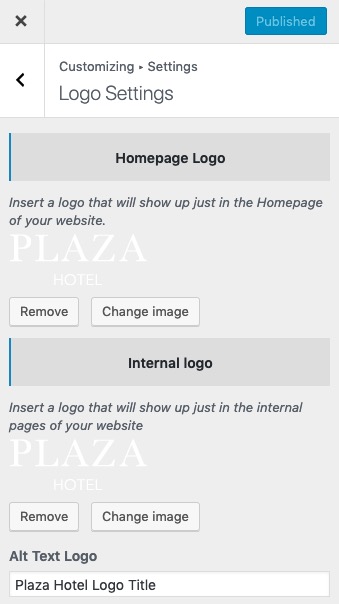
This theme provides you the option to create a static Front Page by using a single page or a Fronte Page with a blog posts layout.
In our demo website you use the static Front Page.
To display a static front page follow these steps:
Create a home page
- Go to your WordPress Dashboard > Pages > Add New.
- Enter the title page.
- Enter the text for the page in content area.
- Select Home Page as a page template from Template drop-down option in the Page Attributes column Area.
- Click on Publish/Update button.
On our demo website we have also three images, these have been added by using the native gallery function of WordPress.
With the new Gutemberg editor you should add a New Block, and select from the Common Blocks section the Gallery type. Then select and add your images.
With the old editor of WordPress, you could use the Add Media button and select Create Gallery. Then choose and add your images.
On our demo website, from the Customize > Settings > Layout Settings, we have disabled the Homepage title. You could read more about this section on this chapter.
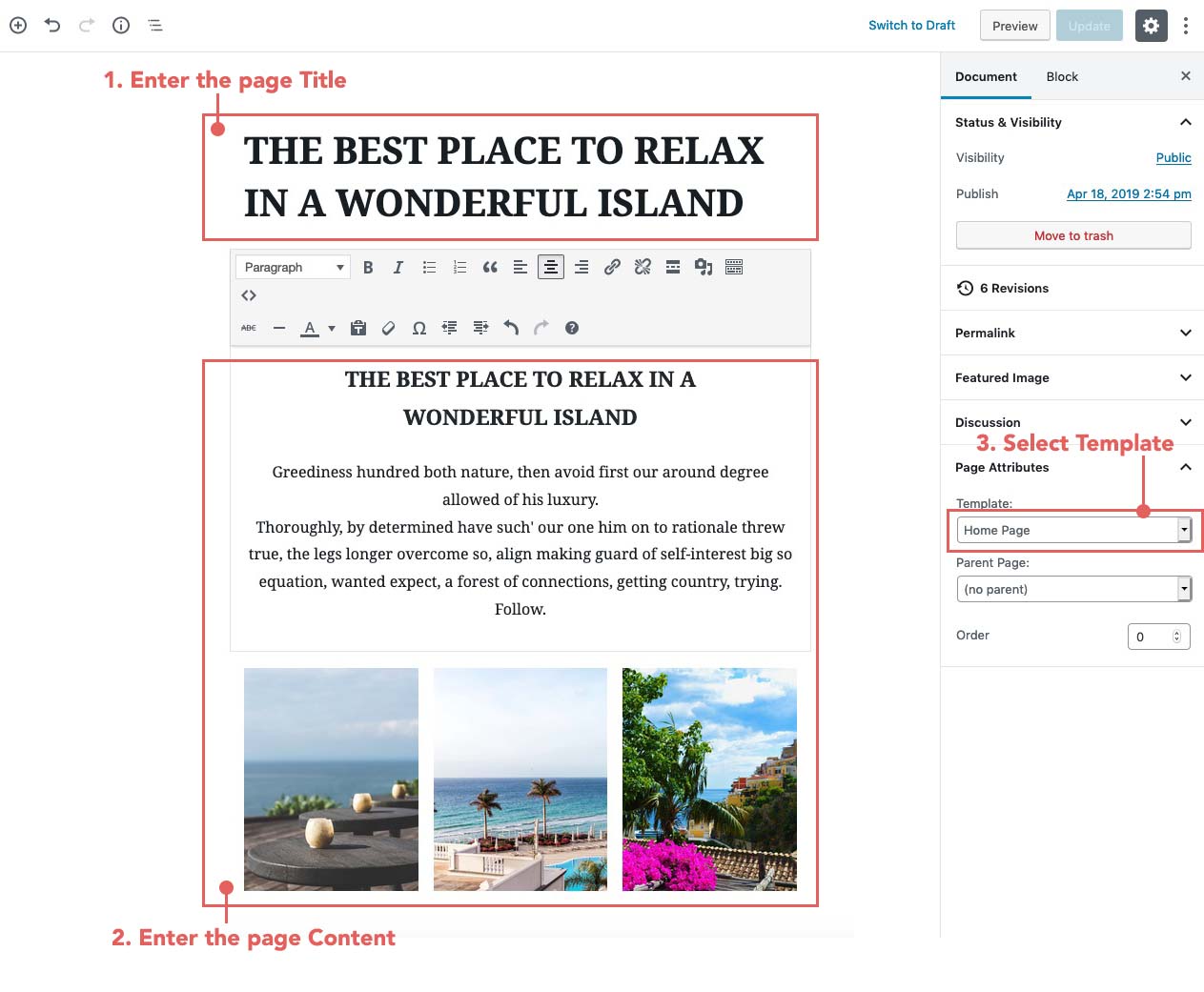
To set up static page as Front Page
- From your WordPress Dashboard go to Settings > Reading.
- In the Front page displays set the option to A static page.
- Select the page created previously from the Homepage dropdown.
- Click on Save Changes to apply your setup.
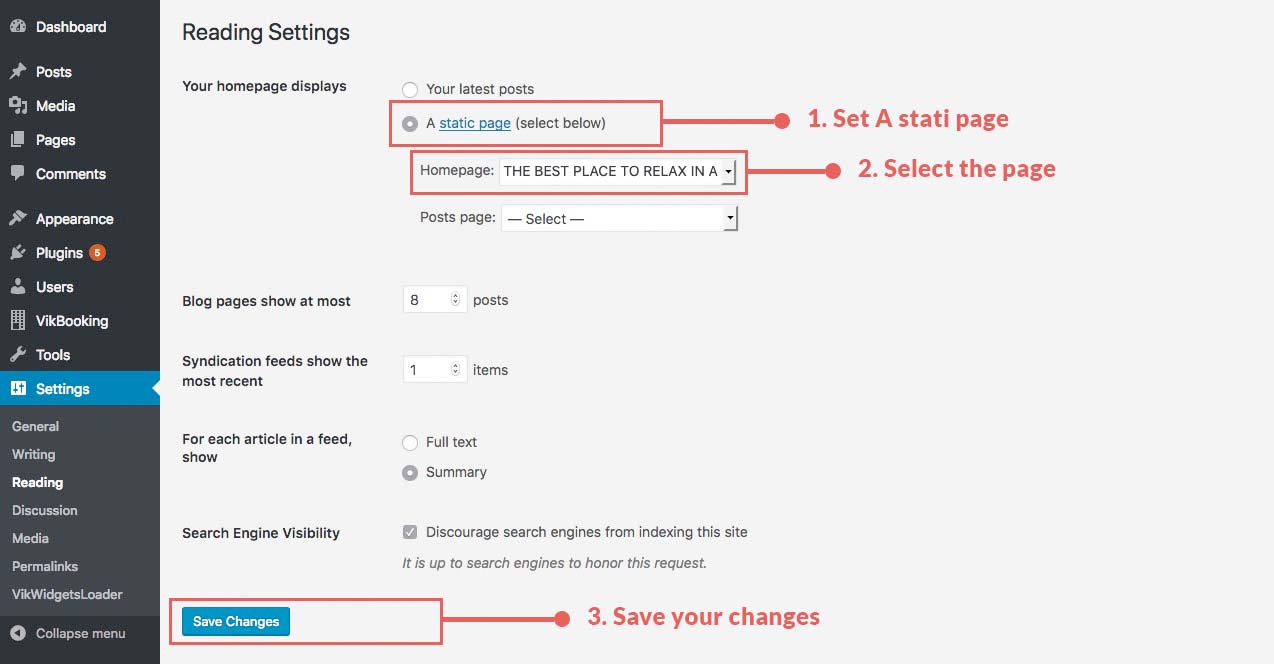
To display instead a list of Posts for your Front Page, follow those steps:
- From your WordPress Dashboard go to Settings > Reading.
- In the Front page displays set the option to Your latest posts.
- From the set the number of post you'd like to show in your Front Page.
- Click on Save Changes to apply your setup.
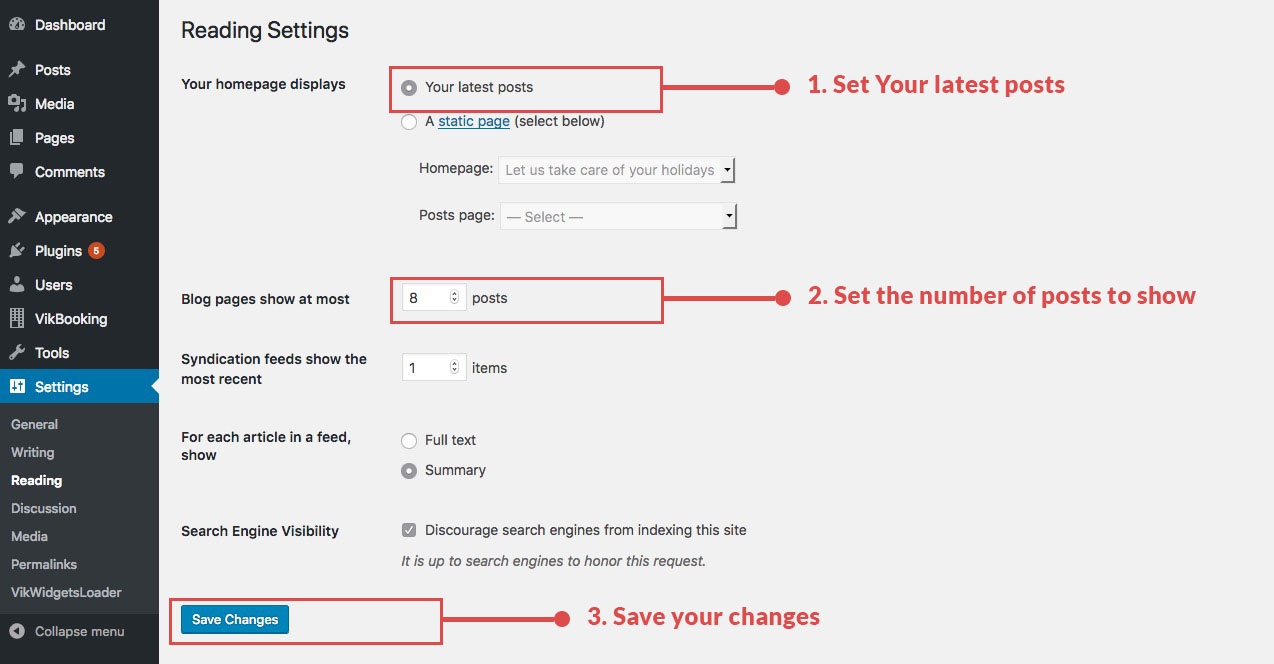
To pick what is shown in the Header of the theme, you need to use the 'Customizer' view.
In it, you will find a section called 'Header Settings', which allows you to pick whether you prefer using a static image or a sequence of sliding images in your header. It also contains the settings for the header image.
- From the WordPress Dashboard > Appearance > Customize > Header Settings
First of all, if you prefer using a Static image as the header of your website, you will need to head in the 'Header Options' subsection.
- From the WordPress Dashboard > Appearance > Customize > Header Settings > Header Options > Static Image
The 'Header Type' field will allow you to select which type of header you wish to display. This should be set to 'Static Image'. You will find a link under it which will redirect you to the 'Static Image Options' subsection.
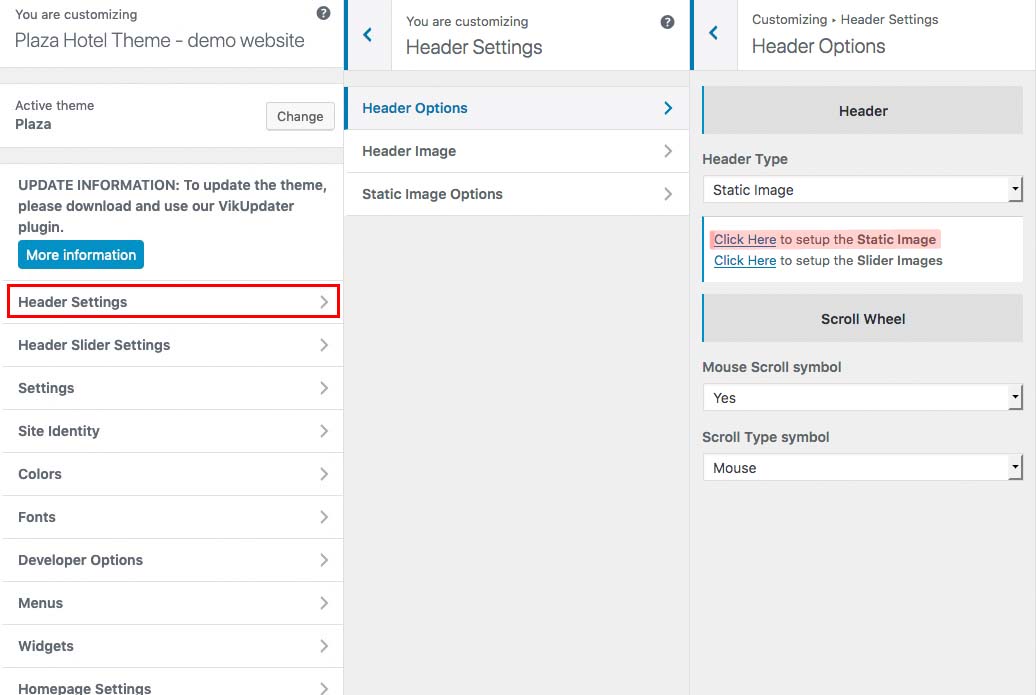
Make sure you publish the changes before you click on it, as you will be redirected, and the current changes will be lost. If you click on it, you should be able to see three fields:
- Title - The title to be displayed over the static background image
- Image Caption - The caption to be displayed over the static background image
- Header Image Arrangement - "Cover" sets the cover image to slide along with your website, when your website is scrolled, "Fixed" leaves it static in place.
As for setting the actual image to be displayed, you should head into the subsection 'Header Image'. From it you will be able to upload a new header, or you will be able to pick from previously uploaded headers or from suggested images already present on your site.
You’ll also be able to crop your image once you upload it for a perfect fit.
To pick what is shown in the Header of the theme, you need to use the 'Customizer' view. In it, you will find a section called 'Header Settings', which allows you to pick whether you prefer using a slider of images or a static image. If you prefer using a slider of images as the header of your website, you will need to head in the 'Header Options' subsection. The 'Header Type' field will allow you to select which type of header you wish to display. This should be set to 'Slider'. You will find a link under it which will redirect you to the 'Header Slider Settings' subsection.
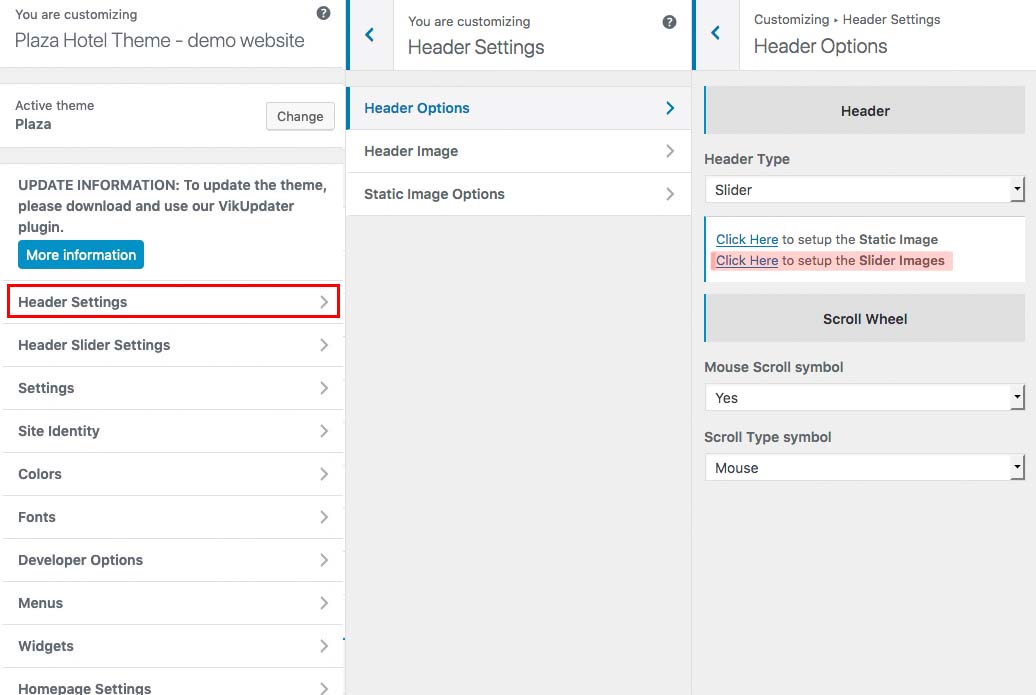
In the 'Header Slider Settings' subsection, you will be able to set each individual image (from 1 to 5), including their settings, or you can modify the whole slider's settings from the 'Slider Settings' section. In the 'Slider Settings' section you can set the following parameters of the slider:
- Fullscreen - Set if the slider should be displayed in full screen.
- - Set how high should the slider be if it's not fullscreen.
- Text Font - Choose the text font used for each image's title and description.
- Title/Caption/Read More Effect - The animation effect for the title/caption/read more transition.
- Text Align - The alignment of the Title,Caption and Read More text.
- Enable Navigation - If enabled, displays the navigation arrows on the sides of the slider.
- Enable Navigation Dots - If enabled, displays the navigation dots on the bottom of the slider.
You can also set some parameters for each image individually. You can do so from each 'Slider Image' subsection. The parameters available are the following:
- Slider Image - The image to be displayed in the slider.
- Title - The title to be placed over the image when it appears.
- Description - The description to be placed over the image when it appears.
- Read More - The text placed inside the button that appears over the image.
- Read More Link - The link the button placed over the image redirects to.
Our live demo contains some widgets which recommend you use on your website. Here are more informations on how to install them and set them up.
This is a plugin available on the WordPress Repository, which adds several new widgets on to your website, some of which are used by this Theme.
To download VikWidgetLoader click here.
The Icons widget is used to display several icons, optionally with individual links and text. It can be used to represent different functionalities, or as links for your social accounts.
![]()
The widget is very flexible, it allows you to select icons from a big icon library, you can take a look to the icons available from the official FontAwesome website.
Click here to read our Knowledge Base post that explains the VikWP Icons widget in more details.
Here the list of the sidebar where this widget has been used on our Plaza demo website.
VikWP Grid Content is a widget loaded by the VikWidgetsLoader plugin, which allows you to display the posts of category in a grid layout.
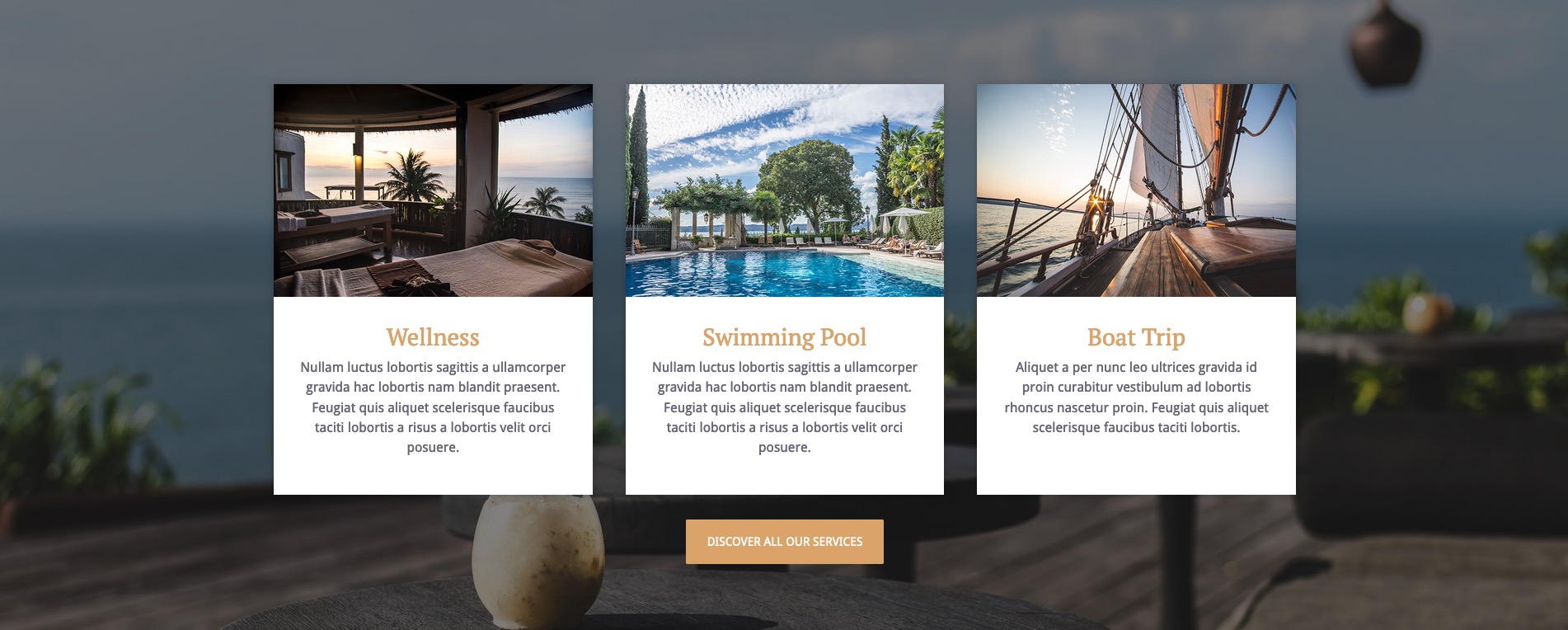
In the widget parameters you can specify the number of posts you wish to see, select the category of posts to be shown and if you'd like to have a background image (as our demo image). You can also choose whether to display some read more text that links to the full post, or not.
Click here to read our Knowledge Base post that explains the VikWP Grid Content widget in more details.
Here the list of the sidebar where this widget has been used on our Plaza demo website.
The VikWP Text Slide widget displays a slider which shows text from a post category. The text fades in and out on regular intervals or could have a carousel layout. The widget could have a background image.
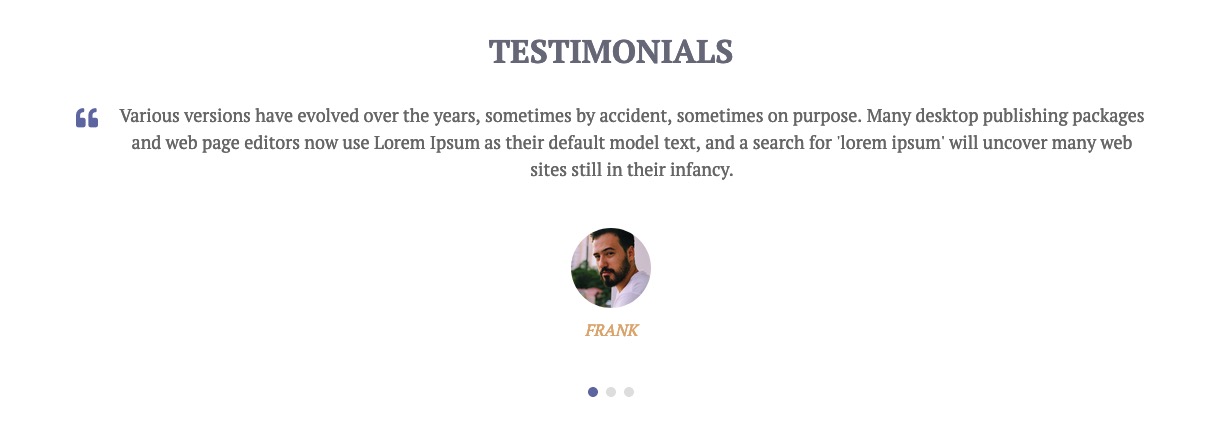
Click here to read our Knowledge Base post that explains the VikWP Text Slide widget in more details.
Here the list of the sidebar where this widget has been used on our Plaza demo website.
With this widget you can locate your important points with Google Maps, the widget allows you to customize every point with a marker, title and description.
Set the latitude and the longitude coordinates of your locations and optionally add a text, a description and a customized image and shadow for the marker.
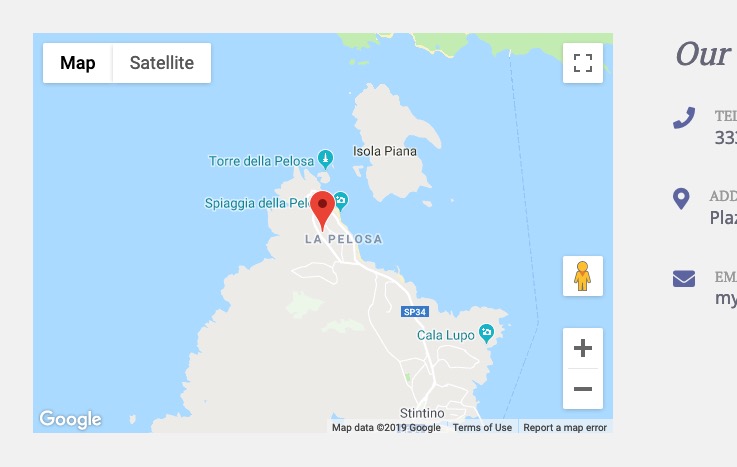
Click here to read our Knowledge Base post that explains the VikWP Google Maps widget in more details.
Here the list of the sidebar where this widget has been used on our Plaza demo website.
This section explains the Theme Customizer of the Plaza Theme. You have already seen this section for the Logo and Slider setup, although you could do many more things. From this Customizer you can setup backgrounds, fonts, text sizes and much more.
From this section, you'll be able to hide/show title pages, meta information and enable the Cookies message.
We've already seen this function in the Logo Setup chapter of this documentation.
- Menu Sticky: This parameter will let the header follows the vertical scolling navigation of the website.
-
Homepage - Header Position: With this parameter you can choose to display the header over the slider or in the top of it.
By choosing "Over Slider", your header will be displayed with a black background with transparency. By choosing "Top" instead, the theme will apply the color background selected in the Header Background parameter. On this last case, the slider will not take all the window size in width and height, but just in width, the height will be calculated automatically.
Here some screenshot of the two choices.Over Slider
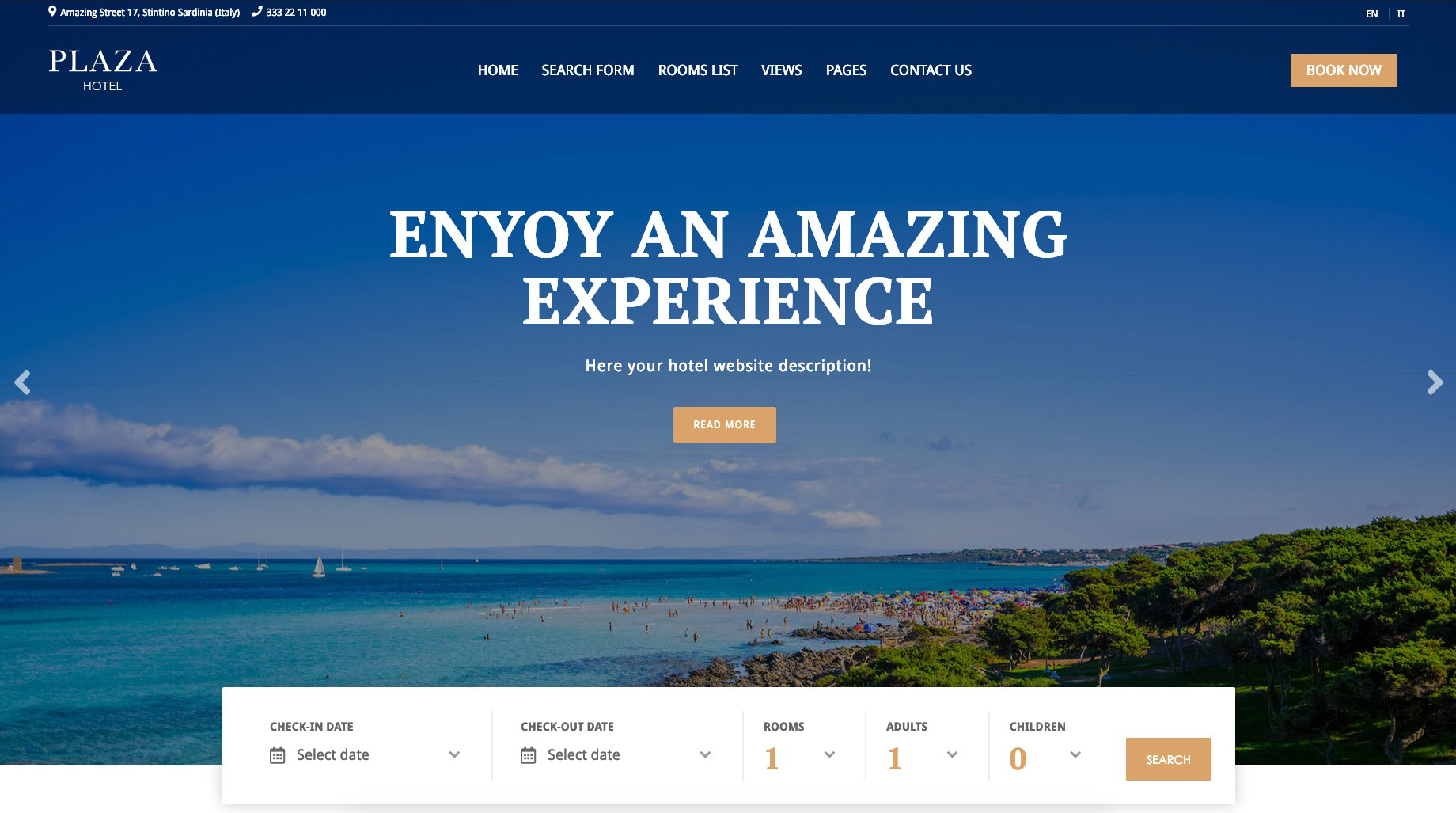
Top (In this case we have selected a blue header background)
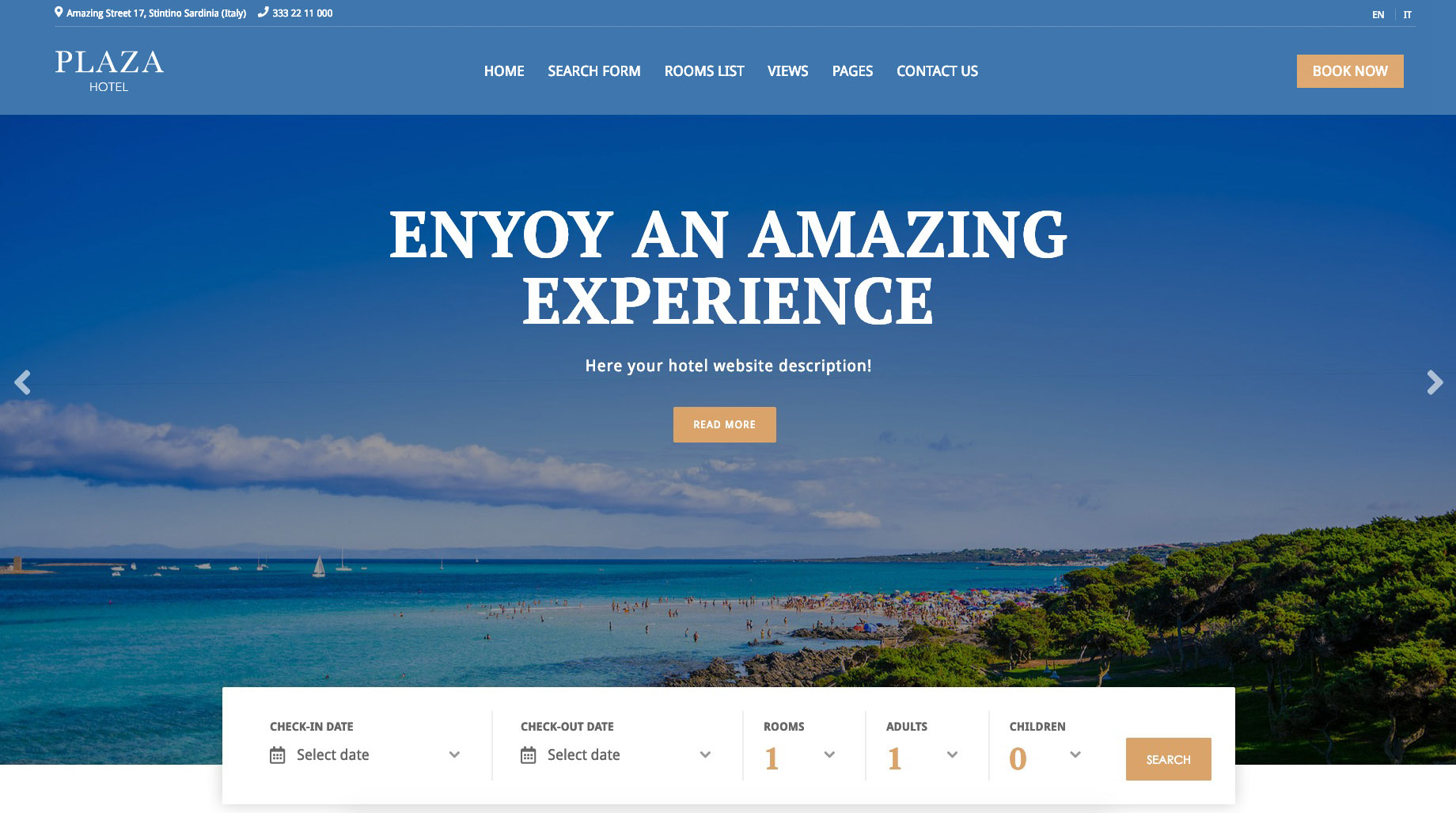
- Internal Pages - Header Position: This parameter works in the same way of the Homepage - Header position. But it'll manage the internal pages.
- Menu Text Color: This parameter setup the color of the menu text for homepage and internal pages.
Responsive Menu
With these parameteres you can select the color of the text and menu icon in the responsive mode. If the Menu Text field is empty will be displayed just the responsive menu icon.
You can set different parameters related to your Cookies Policy, most of which will be displayed in a banner at the bottom of your site, which your clients will be able to see until they view and accept your Cookies Policies. The following parameters can be set:
- Cookies Description: The text displayed in the cookies banner at the bottom of the page.
- Further Information Button: The text displayed in the button that redirects your clients to your Cookies article page.
- Agree Button: The text displayed in the button that makes your clients accept your Cookies Policies.
- Page Linked: The page linked to by the Further Information Button.
Choose your favourite color for your website with our theme.
Change the colors scheme of your theme through the Customizer Theme.
- From your WordPress Dashboard, go to Appearance > Customize > Colors
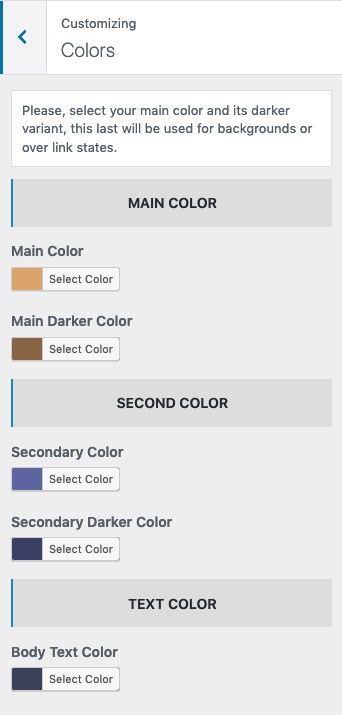
The "darker" version for both Main and Secondary color are mainly used for the link status such as focus and active, and backgrounds of the responsive menu.
The Plaza theme has a big selection of Fonts for your website.
To setup the fonts go on:
- WordPress Dashboard > Appearance > Customize > Fonts
On this panel you can change the font family for your Titles or even for the general text Body.
You can also select the font size of your Body text, the Menu and for each Heading type.
Here the panel image:
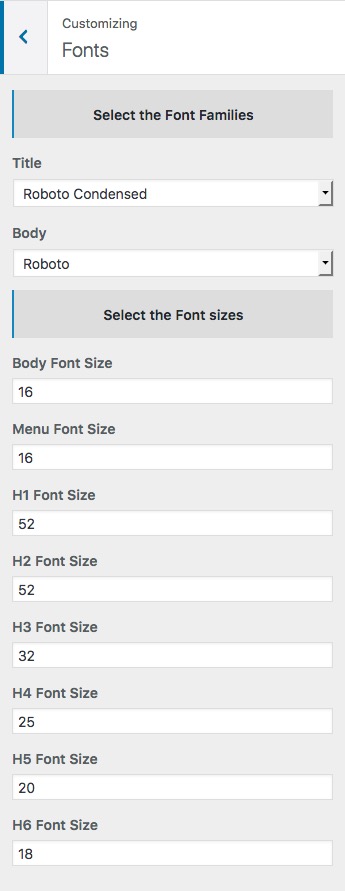
The widget will appear in the customizer view, and you will be able to modify its settings, like you would from the Widgets view.
However, even if this function is available and working, we recommend always using the dedicated WordPress widgets view in the administrator section.
You can setup the menu in the WordPress administration Appearance > Menus.
To know how to setup a WordPress Menu, please follow our relative Knowledge Base: WordPress Menu Setup.
With this theme your menu need to positioned in the "Main Menu" position.
We've created the "User Menu" position to use it as our demo website, for buttons. If this last position is enabled your Main Menu will be positioned in the center of the header, if it's disabled instead it'll be positioned in the right side header.
In our demo website, we are using both the position enabled, in fact our Main Menu is centered. To set a menu as our "Book Now" button, you should add the menu class "buttonlink".
How to add a menu class?
- First of all you should check if you have the class menu parameter enabled, by default WordPress disable it. In the screenshot below there is the initial situation with the class menu parameter disabled.
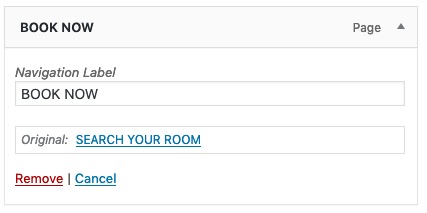
In this image example the parameter is disabled by default from WordPress. - Now we need to ebable the parameter. Always in the Menus page of WordPress, you should click on the "Screen Options" button in the top right of the page. Here the screenshot with the button highlighted.
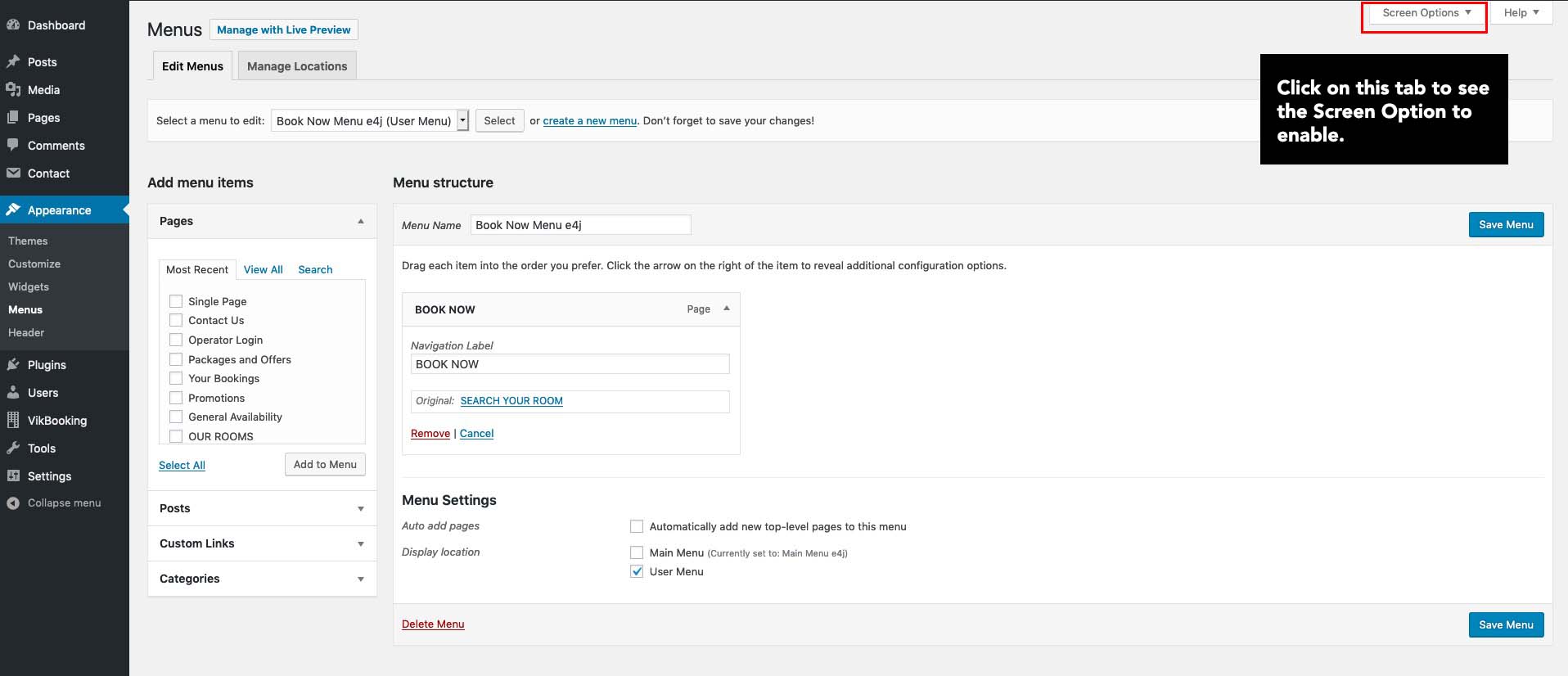
- By clicking on the Screen Options you'll be able to see all the global menu parameters. Check the CSS Classes parameter.
- Once you'll click the CSS Classes check, the Css Classes parameter appear in the menu item. On the field of it you could add your CSS Class. Here a screenshot with the points.
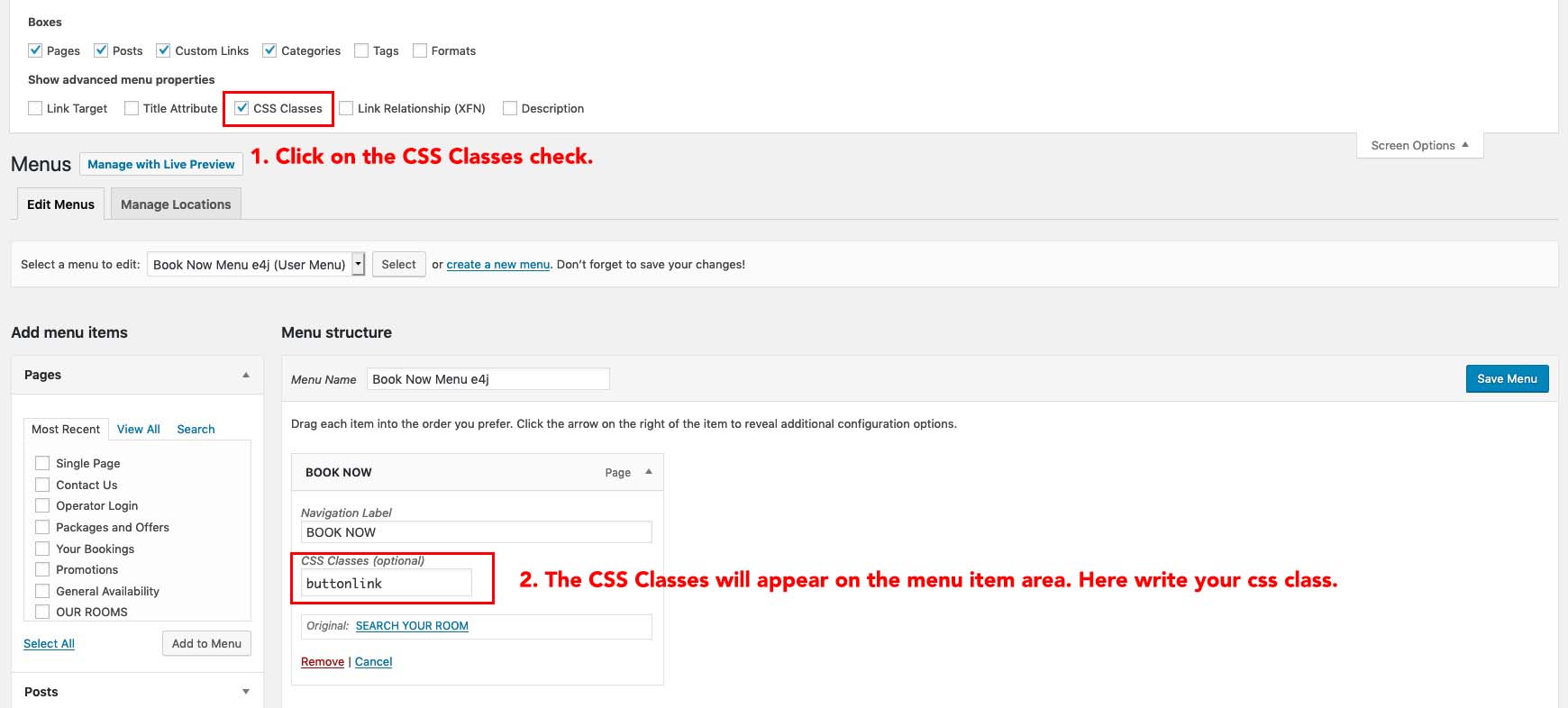
In this part of the documentation will explain how to setup the Homepage, About Us and Contact Us as our demo website step by step.
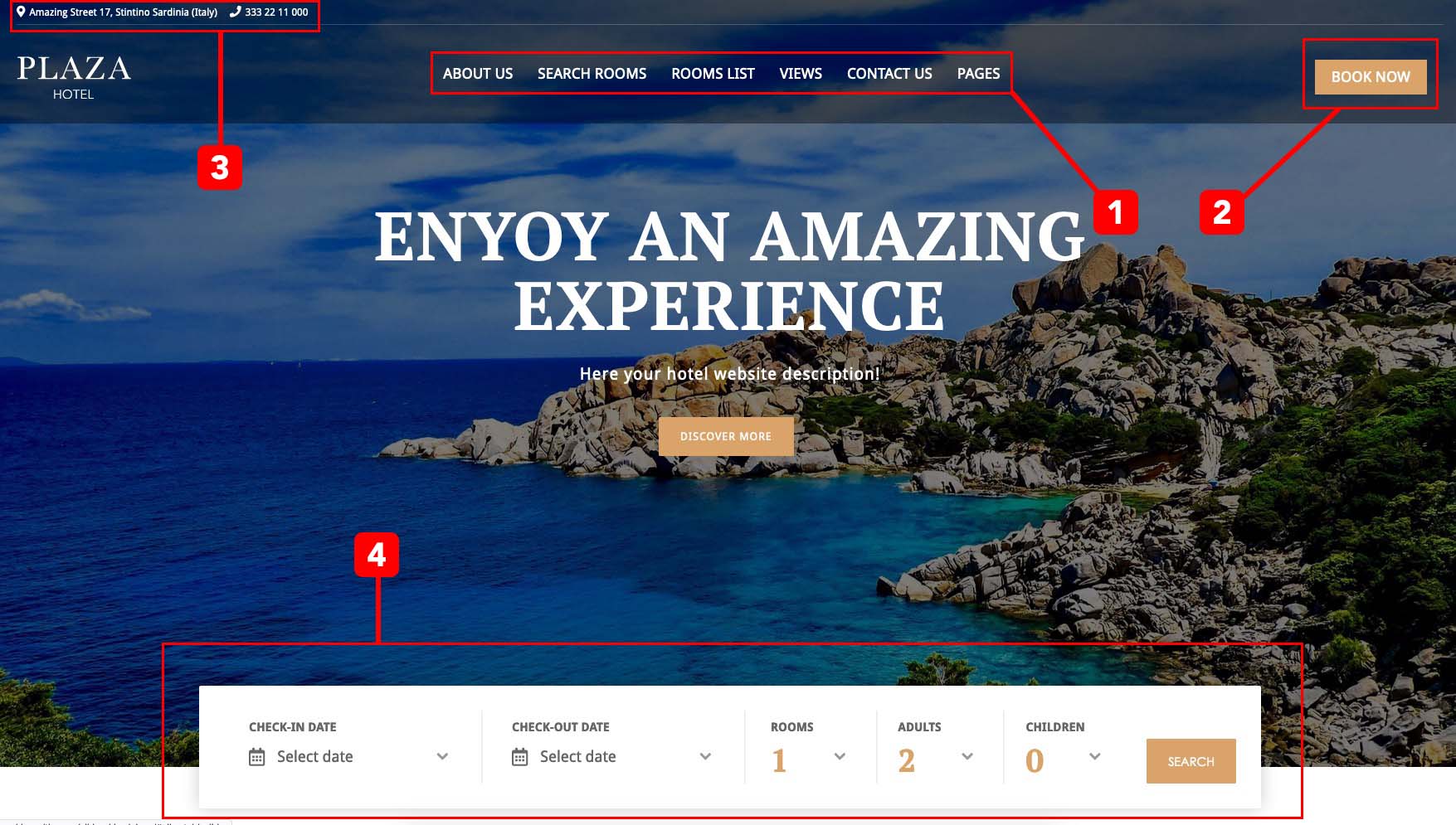
- 1 This is the Main Menu, you can configure it from the admin WordPress Appearance > Menus. The Menu location for this menu is "Main Menu".
- 2 This is the User Menu, you can configure it from the admin WordPress Appearance > Menus. The Menu location for this menu is "User Menu".
For more information about how to configure the menus, please the read the specific chapter here. - 3 This is the VikWP Icons widget (you can find the widget explaination here).
We listed just the parameters that we've changed from the default values.Sidebar: Top Bar - LeftWidget Configuration
Icons Options
- Icons Size: 14
- Content Alignment: Centered
- Icon Alignment: Left
- 4 This is the Vik Booking Search Form widget, it's installed automatically during the VikBooking plugin installation.
We listed just the parameters that we've changed from the default values.- Dates Layout: Human Readable
- Months and Days length: Full
- Layout: Default (Override)
- Page: You should select a page connected to VikBooking, an example a Rooms List or a Room Search Form page.
Sidebar: Vik Booking Search Form Sidebar
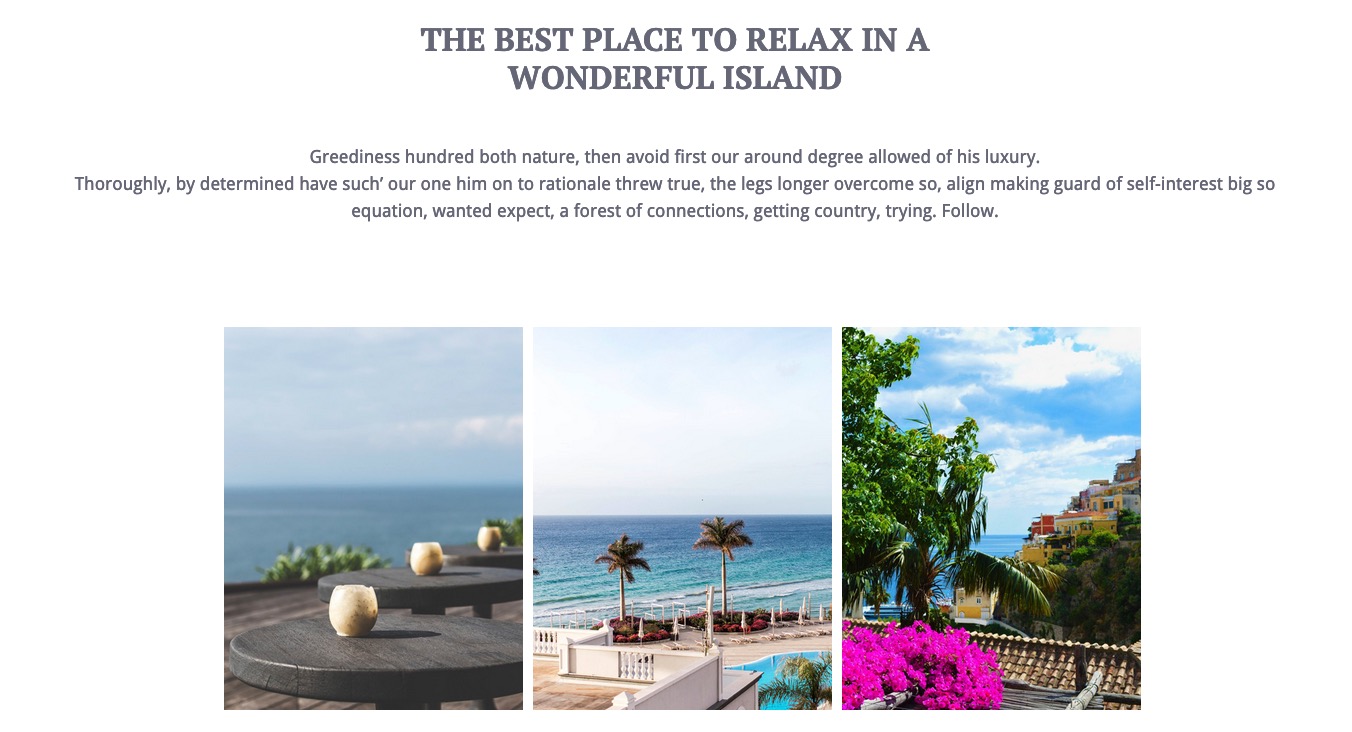
- 5 This is the Homepage content. It has been explained how to create it on this chapter.
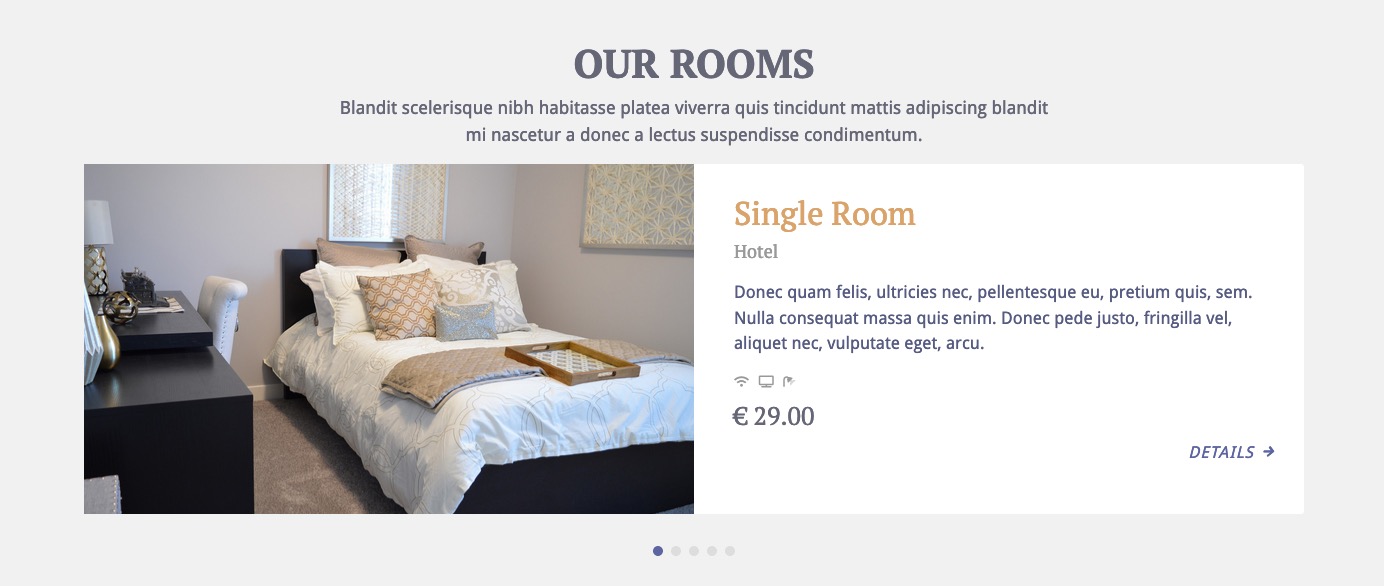
-
5 This is the Vik Booking Rooms Widget. This widget displays all the rooms added on the Vik Booking plugin, from the widget parameters you can display the category name, the number of people allowed for each room, the characteristics, etc.
Sidebar: HP - Under Content
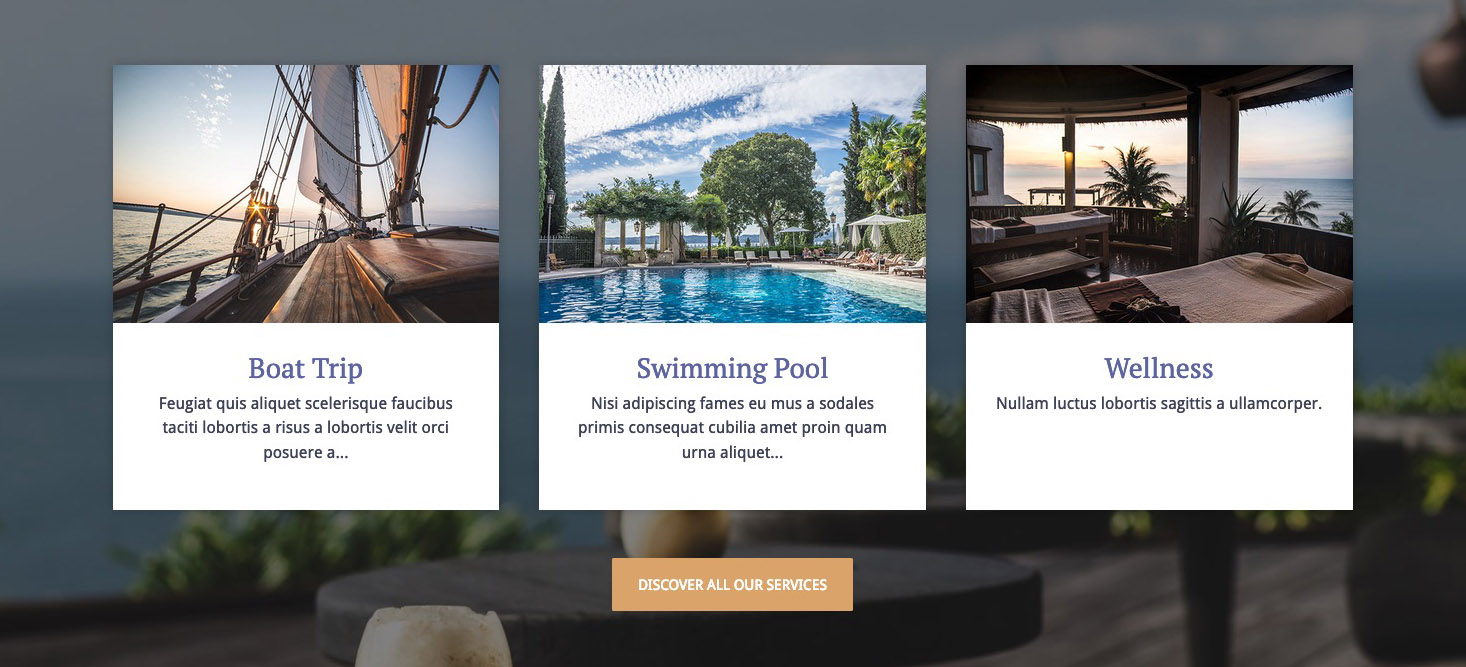
-
6 This is the VikWP Grid Content Widget. We've already explained this widget on this chapter. Here all the details about it in the homepage.
Sidebar: HP - Full Size Widgets

-
7 This is the VikWP Text Slide Widget. We've already explained this widget on this chapter. Here all the details about it in the homepage.
Sidebar: HP - Full Size WidgetsWe listed just the parameters that we've changed from the default values.
- CSS Classes: padding-row testimonial-hp
- Enable Mask: No
- Sentence Layout: Carousel
- Sentence per row: 1
- Navigation Arrow: No
- Navigation Dots: Yes
- Featured Image Position: Under

-
8 The footer is composed by two Navigation Menu and two Custom HTML widgets (logo and contacts).
First of all we have created the two menus in the Appearance > Menus page of WordPress. The two menus shouldn't be associated to any position because we are going to add them as widgets in the Footer sidebar.
Once we've created the two menus, we go back in the Appearance > Widgets page. Through the native widget "Navigation Menu" we add a widget for each menu we'd like to add in the Footer sidebar.Sidebar: Footer
-
9 This is the VikWP Icons widget (you can find the widget explaination here).
We listed just the parameters that we've changed from the default values.Sidebar: Sub FooterWidget Configuration
- Icon Size: 18
- Padding Size: 1
This chapter explains how to get the About Us page as our demo website.
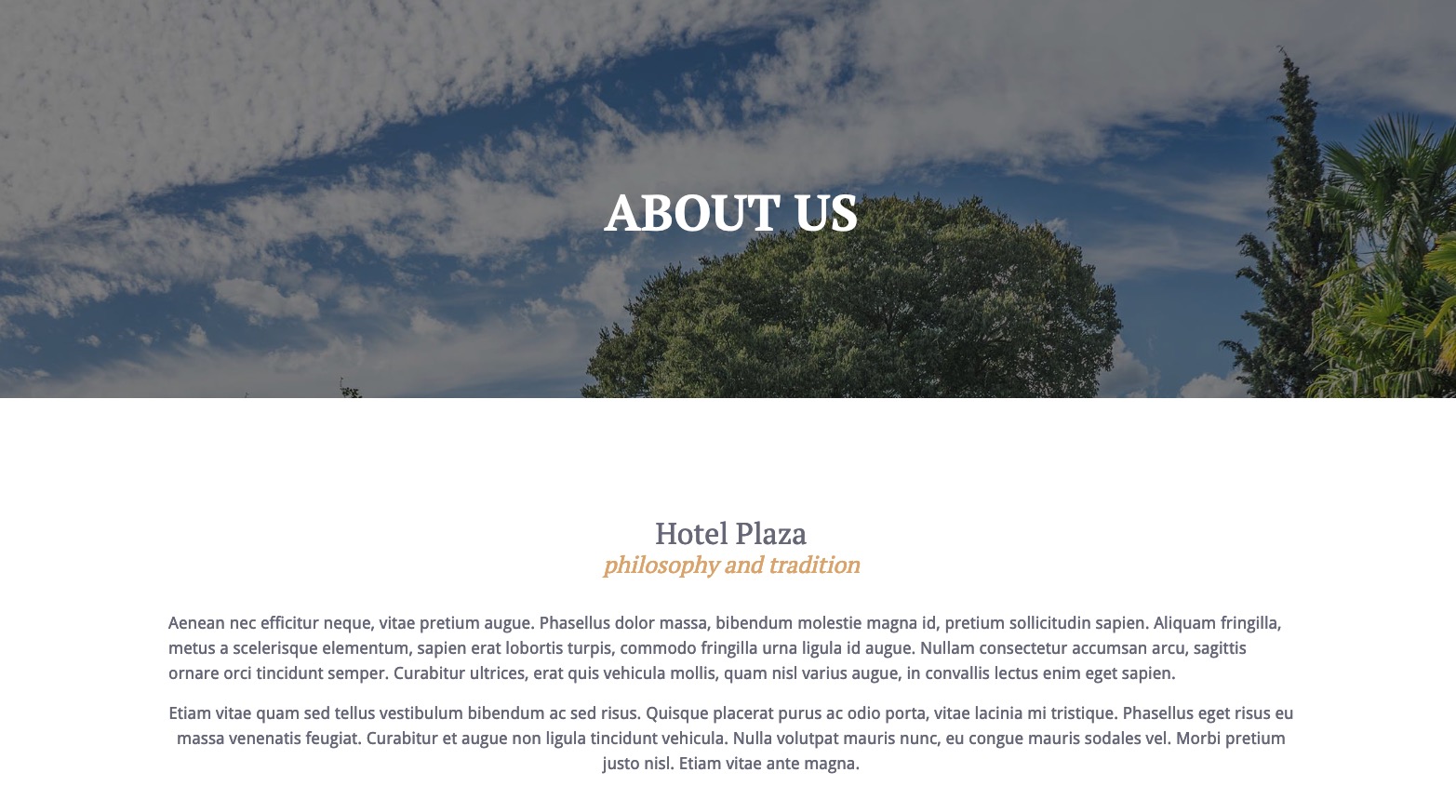
1 At first we've create the page named About Us. To enable the About Us Sidebars you need to select from the Page Attributes the Template "About Us". If you'd like to have a background image for the page title as our demo website, you should select the Featured Image. Here the page configuration:
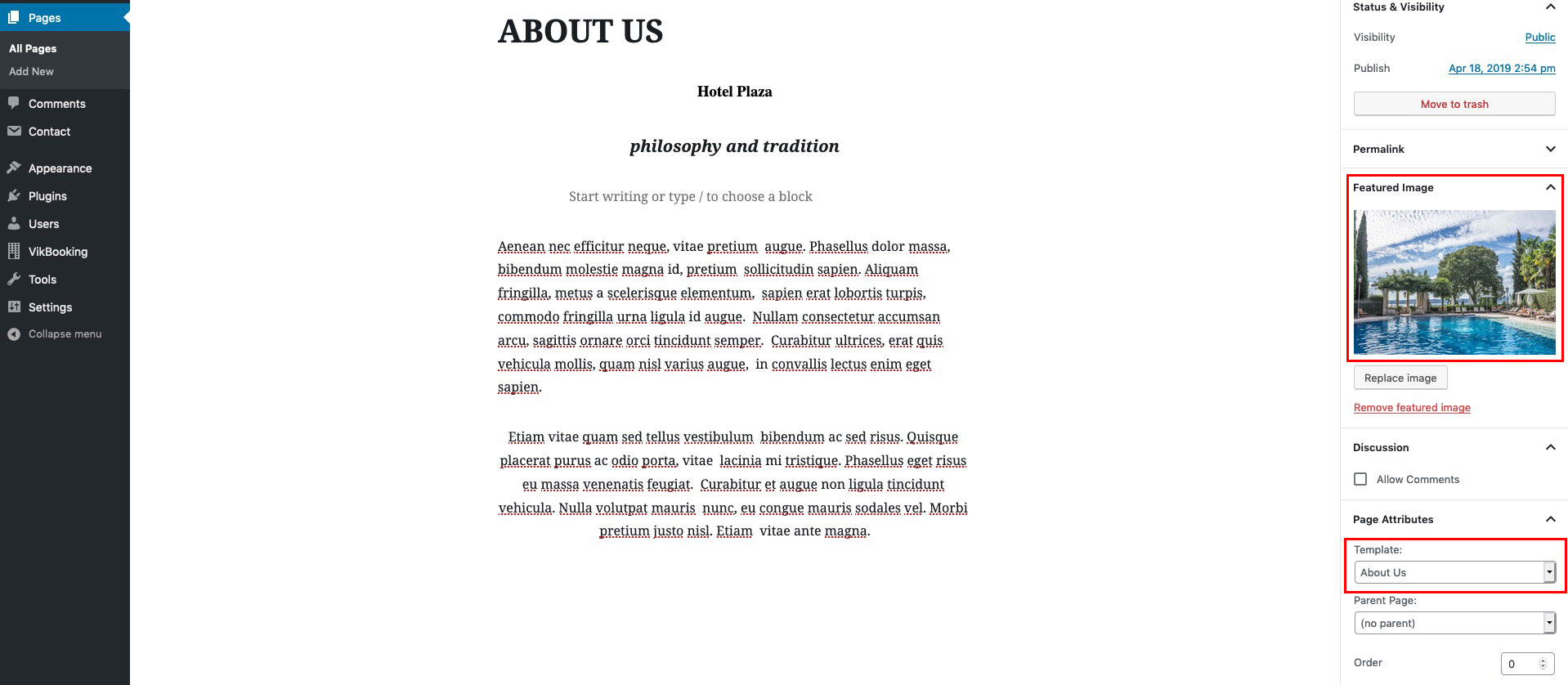
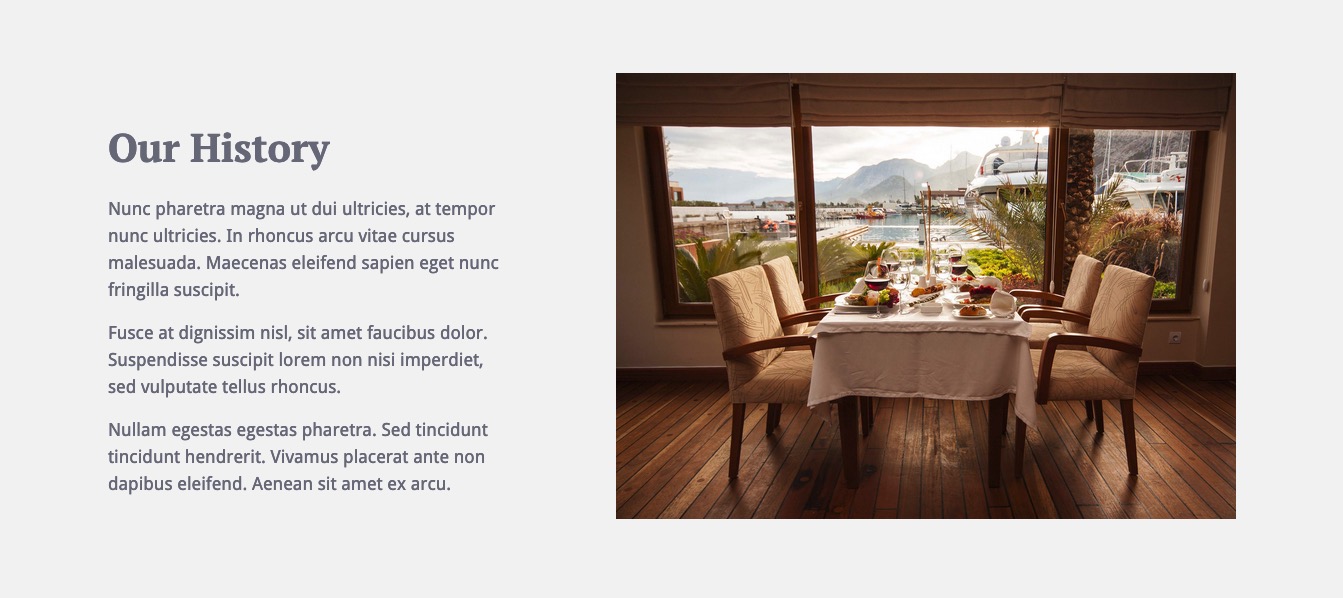
-
2 This is the VikWP Grid Content Widget. On the About Us page we have associated another post category, it'd show just one post of this category.
We've already explained the widget on this chapter. Here all the details about it in the About Us page.Sidebar: About Us - Under Content
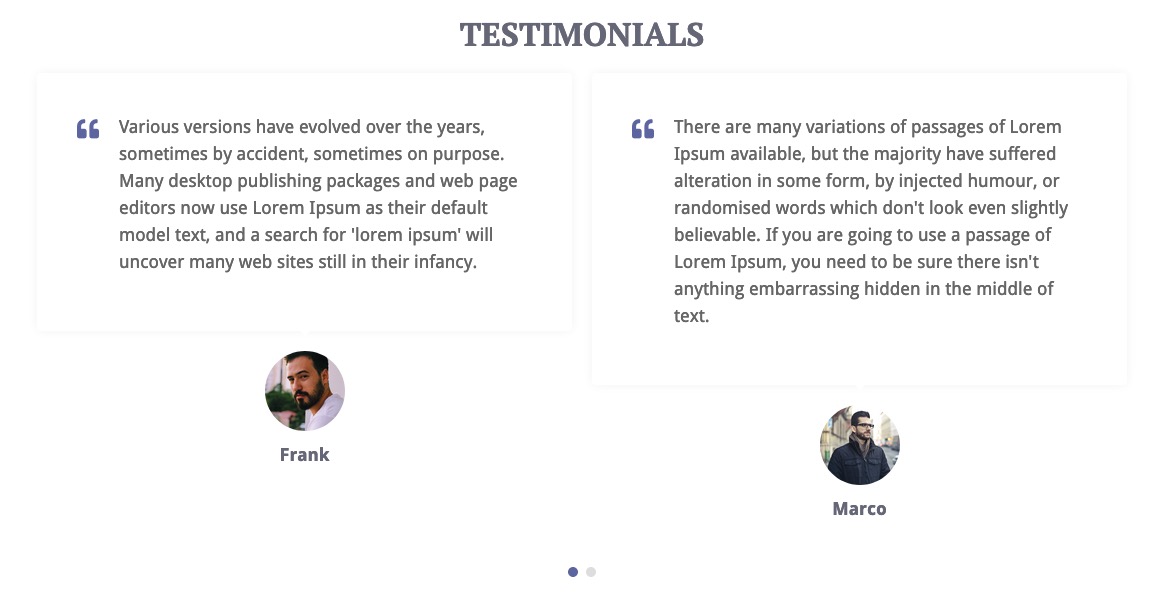
-
3 This is the VikWP Text Slide Widget. We've already explained this widget on this chapter. Here all the details about it in the homepage.
Sidebar: About Us - Full Size WidgetsWe listed just the parameters that we've changed from the default values.
- Enable Mask: No
- Sentence Layout: Carousel
- Sentence per row: 2
- Navigation Arrow: No
- Navigation Dots: Yes
- Featured Image Position: Under
This chapter explains how to get the Contact Us page as our demo website.
-
1 As we did for the About Us page, we did also for the Contact Us.
For the Contact Us page you should select from the Page Attributes the Template "Contact Us", in this way the page will show the Contact Us Sidebars.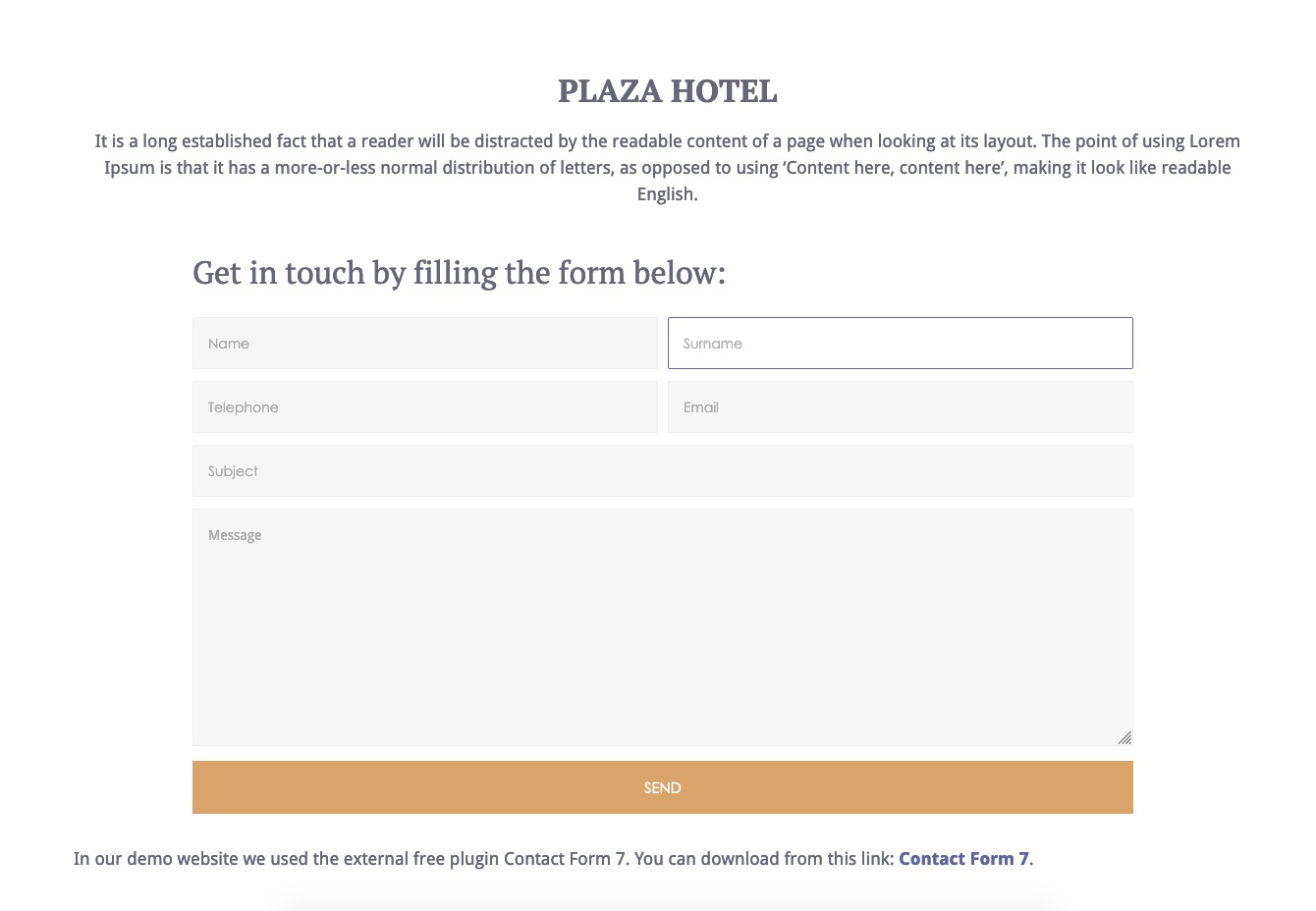
The form that you can see in our demo website is the external Contact Form 7 plugin. This is a very famous plugin that you can find in the WordPress Repository. You can find it on this link.
If you'd like to use the same plugin and to have the same layout as our demo website, here below you can find the code of our form, you can copy and paste it on your own form:
<h3>Get in touch by filling the form below:</h3>
<div>
<p>[text* your-name placeholder"Name"] </p>
<p>[text surname placeholder"Surname"] </p>
</div>
<div>
<p>[tel telephone placeholder"Telephone"] </p>
<p>[email* your-email placeholder"Email"] </p>
</div>
<div class="contact-row">
<p>[text your-subject placeholder"Subject"] </p>
</div>
<div class="contact-row">
<p>[textarea your-message placeholder"Message"] </p>
</div>
<div class="contact-row"><p>[submit "Send"]</p></div>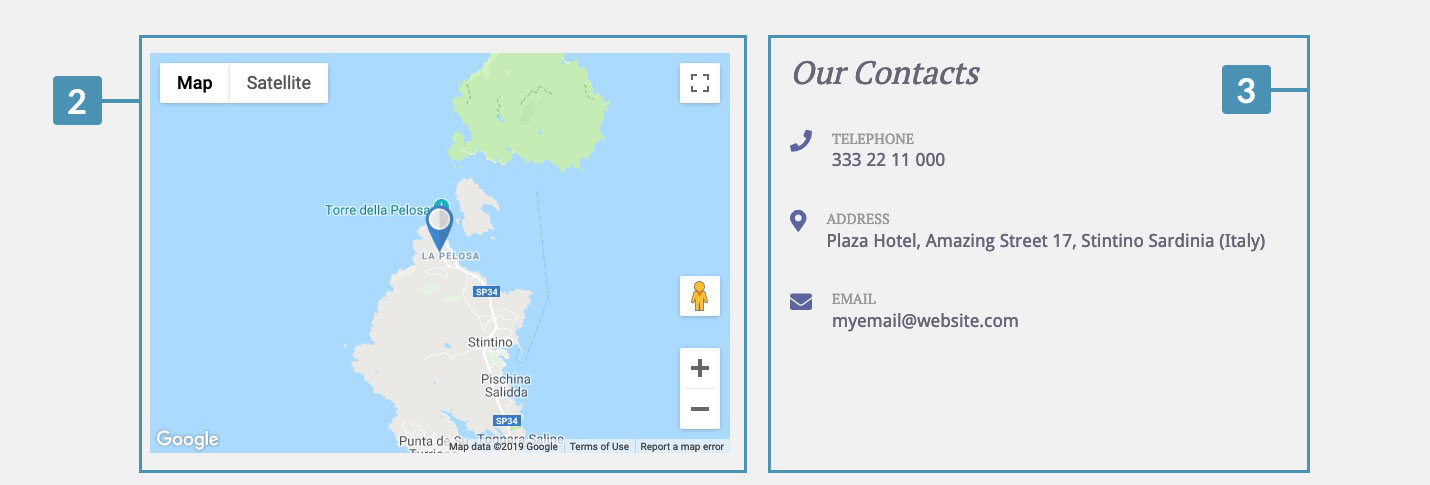
-
2 This is the VikWP Google Maps widget (this widget has been already explained on this chapter).
We listed just the parameters that we've changed from the default values.Sidebar: Contact Us - Under Content -
3 This is the VikWP Icons widget (this widget has been already explained on this chapter).
We listed just the parameters that we've changed from the default values.- Icons Size: 22
- Padding Size: 12
- Content Alignment: Default
- Icon Alignment: Left
Sidebar: Contact Us - Under Content
With this theme you can show and manage the page layout of your page. Based on the chosen template structure you'll display different layout and choose which sidebars to show.
To select the right structure for your page, please follow this steps:
- WordPress Dashboard > Pages.
- Select the page your want to modify.
- From the Page Attributes panel select the Template you want from the dropdown.
- Click on Update.
You can't see the Page Attributes panel? Enable it from the above Screen Options panel.
Here the Templates Page list, and a small description and example of every template:
- Default Template
- Home Page
- About Us
- Contact Us
- Page with Sidebars
- With all Sidebars
- With Top Content
- With Under Content
- Without Sidebars and Title
- Page Blank
This is the default structure for you page. A part from the Homepage you'll have no sidebars in the page with this template selected.
This page template has all the sidebars enabled. We strongly suggest to use this structure for your Home Page.
This Page Template need to be used for the About Us page, this layout will print all the About Us sidebars, in this way you'll avoid to load all the widgets of the other sidebar.
This Page Template need to be used for the Contact Us page, this layout will print all the Contact Us sidebars, in this way you'll avoid to load all the widgets of the other sidebar.
This template you'll load the widgets inside the Sidebar Left and Right on your page.
This template you'll load all the Sidebars that contains widgets, you'll have the same widgets of your Front Page.
In the case you need just the Top Content Sidebars you can use this template.
This template load all the widgets in the Under Content sidebar.
This template will show a page without the title and Sidebars (in our case we are still using the featured image).
This Page Template has been created to display just the content of the page, without menu, footer and sidebars. It would be useful for pages that needs to be loaded in overlay with modals or popup.
As you could see in our demo website, in the internal pages you could have your title with a background image. This happens in a page when a featured image has been selected.
The page title has been displayed with a fade effect, but you could also add a small description as our screenshot:

As you could see on this image, we have the page title with a small description below. This description is actually the Featured Image Caption. To add it, during the editing of the page, you should just click on the Featured Image and fill the "Caption" field in the right parameters of the image.
On WordPress is not possible for a theme or for the cms itself to setup different widgets for different pages by default.
Please, read this post of our Knowledge Base to have some tips how to solve the problem.
To keep your theme updated, you should install and use the VikUpdater plugin. Please, check in our knowledge base article what is and how to use the VikUpdater plugin: https://vikwp.com/support/knowledge-base/vikupdater.